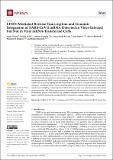LINE1-Mediated Reverse Transcription and Genomic Integration of SARS-CoV-2 mRNA Detected in Virus-Infected but Not in Viral mRNA-Transfected Cells
Author(s)
Zhang, Liguo; Bisht, Punam; Flamier, Anthony; Barrasa, M. Inmaculada; Friesen, Max; Richards, Alexsia; Hughes, Stephen H.; Jaenisch, Rudolf; ... Show more Show less
Downloadviruses-15-00629-v3.pdf (1.843Mb)
Publisher with Creative Commons License
Publisher with Creative Commons License
Creative Commons Attribution
Terms of use
Metadata
Show full item recordAbstract
SARS-CoV-2 sequences can be reverse-transcribed and integrated into the genomes of virus-infected cells by a LINE1-mediated retrotransposition mechanism. Whole-genome sequencing (WGS) methods detected retrotransposed SARS-CoV-2 subgenomic sequences in virus-infected cells overexpressing LINE1, while an enrichment method (TagMap) identified retrotranspositions in cells that did not overexpress LINE1. LINE1 overexpression increased retrotranspositions about 1000-fold as compared to non-overexpressing cells. Nanopore WGS can directly recover retrotransposed viral and flanking host sequences, but its sensitivity depends on the depth of sequencing (a typical 20-fold sequencing depth would only examine 10 diploid cell equivalents). In contrast, TagMap enriches the host–virus junctions and can interrogate up to 20,000 cells and is able to detect rare viral retrotranspositions in LINE1 non-overexpressing cells. Although Nanopore WGS is 10–20-fold more sensitive per tested cell, TagMap can interrogate 1000–2000-fold more cells and, therefore, can identify infrequent retrotranspositions. When comparing SARS-CoV-2 infection and viral nucleocapsid mRNA transfection by TagMap, retrotransposed SARS-CoV-2 sequences were only detected in infected but not in transfected cells. Retrotransposition in virus-infected cells, in contrast to transfected cells, may be facilitated because virus infection, in contrast to viral RNA transfection, results in significantly higher viral RNA levels and stimulates LINE1 expression by causing cellular stress.
Date issued
2023-02-25Department
Massachusetts Institute of Technology. Department of Biology; Whitehead Institute for Biomedical ResearchPublisher
Multidisciplinary Digital Publishing Institute
Citation
Viruses 15 (3): 629 (2023)
Version: Final published version